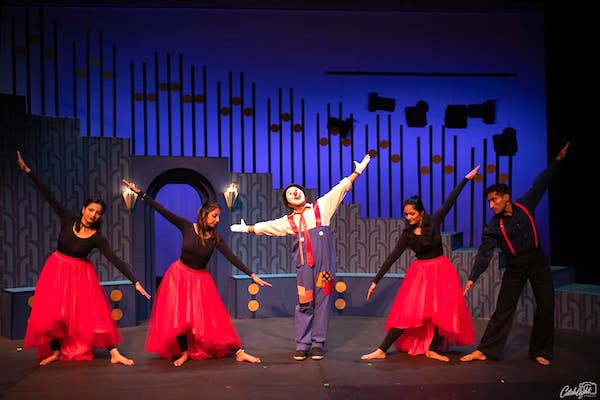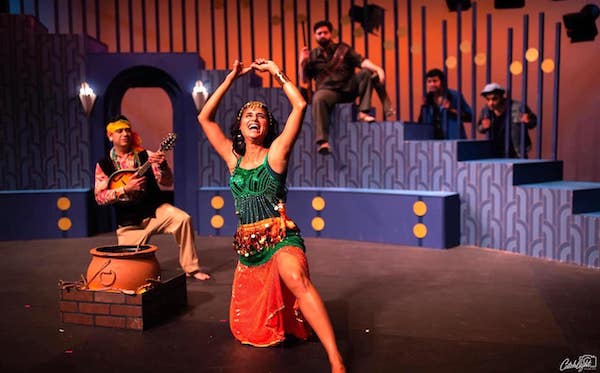‘Bombay Talkies’: A Mesmerizing Journey Through Bollywood’s Golden Years, On Stage
- The storyline revolves around a clapper boy's odyssey through the Hindi film industry from 1935 to 1975 — from iconic films like “Devdas” to “Sholay.”

I had the privilege of experiencing the magic of Naatak’s “Bombay Talkies,” a captivating play that takes us on a nostalgic trip through the heart of Bollywood’s golden era. From the very first encounter with the talented Sujit Saraf during auditions in Palo Alto to witnessing the grand spectacle on opening weekend, this production left me awestruck.
Saraf, in his down-to-earth manner, introduced us to “Bombay Talkies,” a musical extravaganza in Hindi, thoughtfully complemented by English subtitles. The storyline revolves around a clapper boy’s odyssey through the Hindi film industry from 1935 to 1975. From iconic films like “Devdas” to “Sholay,” the play expertly captures the journey, the friendships, the talent, the quirks, and the behind-the-scenes essence of the film industry in India.

I wonder if Saraf intertwined the story of the clapper-boy with his parallel journey of love for filmmaking. Who was Raghu? Was he real or a figment of Saraf’s creative imagination? From learning to hold the slate, assisting in shoots and song sequences to serving as a chauffeur, gateman, teaboy, and confidante, Raghu subtly shaped an industry that would later be known as the megastar film industry that is Bollywood.
One of the standout elements of “Bombay Talkies” was the portrayal of the legendary Kundan Lal Saigal, the first singing superstar of Indian cinema, who asks Raghu the clapper boy “if he can sing” because the movies are Talkies and not silent anymore. It was a hook for the audience to sit back, relax, and enjoy a musical evening studded with memorable songs and lyrics from the bygone era. The interactions between characters like Ashok Kumar who just became the male lead in a film starring Devika Rani because her hero did not show up on set. How Raj Kapoor (Pinky) met Nargis, and they made so many romantic films with unforgettable songs together.

Saraf somehow had inside knowledge of the lesser-known gossip that shaped Bollywood’s history. I did not know that Nargis went to seek permission from the then Prime Minister Morarji Desai to marry her Pinky! I did know that everyone in the RK home was a fan of Archie comics because we borrowed books from the same circulating library in Chembur.
The formation of RK Studios and the legendary RK Films logo brought back fond memories of growing up in Mumbai, with the studio located just across from our home. The play skillfully weaved in various iconic moments, such as the filming of “Mughal-e-Azam” and the recruitment of Bade Ghulam Ali Khan for the epic song “Prem Jogan Ban ke.” It was fascinating to witness the industry’s evolution, with humble beginnings and epic stardoms of Dilip Kumar, Dev Anand, Rajesh Khanna, and Amitabh Bachchan, all backed by Saraf’s extensive research.

The play is a delightful sashay through the glitz, glamour, and bravado of the film industry’s golden years. With quick costume changes, it manages to incorporate numerous beloved songs and anecdotes that are etched in the memories of every Indian who grew up standing in long queues on hot summer days to get a seat inside movie halls, their ears tuned to Vivid Bharti radio for their favorite songs, and eyes peeled to magazines like Stardust and Filmfare. I enjoyed the skillful selection of actors standing in for playback singing legends like Lata Mangeshkar, Rafi, Mukesh, and Kishore Kumar. The play transported us back to a time when these voices were just beginning to enchant audiences.
The play kicks off with a dance number from the film “Sholay” — “Mehbooba O, Mehbooba.” I can see how it may have resonated with the male members of the audience. I wept with joy as the talented singer recreated the golden voice with a nasal twang of K.L. Saigal. I can’t validate the story that Raghu advised Saigal to sing from his nose because he had a cold but almost every singer male or female in that era was emulating Saigal’s voice. I even made friends with a snotty boy thinking he was related to the legendary singer.
I grew up listening to Saigal as a toddler. My father would sing Saigal’s wonderful “Nuktacheen Hai Ghame Dil” composed by Pankaj Mullick in Raga Bhimpalasi based on Ghalib‘s ghazal. “Prem Nagar Mein Banaoongi Ghar Main” from the 1934 film Chandidas (1934). I used to mimic the sing-song conversational quality in the 1930s movie as a kid and laugh out loud at that time but to see these old songs portrayed on stage in the Bay Area by the Naatak group could not stop my tears.
I can still hear my dad singing songs like “Babul Mora Naihar Chhooto Hi Jaaye” from “Street Singer” (1938) “Karun Kya Aas Niras Bhai” from “Dushman” (1939), “Gham Diye Mustakil” from “Shahjahan” (1946) Saigal’s finest film had one of his “memorable” songs “Ik Bangla Bane Nyara” from “President” (1937). Dad’s best friend in Bombay was Justice Madhukar, so he always requested dad to sing the Saigal bhajan like “Madhukar Shyam hamare chor.” The melodies that kept percolating through the wonderful sound system enthralled and transported me to Lahore where families and friends would sleep on connected terraces under the stars to the sound of Saigal’s voice crooning on the loudspeaker ‘So ja Rajkumari”.

The dedication of the cast and crew, who juggled their day jobs while performing, providing live music, and dancing for several weekends in a row, is commendable. “Bombay Talkies” is not related to the 2013 anthology Bollywood film of the same name, offering a fresh and distinct perspective on Bollywood’s history. It is staged at the Cubberley Theater in Palo Alto, and runs for 2 hours and 20 minutes, with a 10-minute intermission. Please note that children under 7 are not admitted.
Saraf recreated an enchanting evening that connected me with my dear father who departed for his heavenly abode on the same day (18th of January, but 66 years apart) as his favorite singer Saigal. I will never forget the performance for this reason.
(Photos, Courtesy Naatak Facebook)
With one foot in Huntsville, Alabama, the other in her birth home India, and a heart steeped in humanity, writing is a contemplative practice for Monita Soni. She has published hundreds of poems, movie reviews, book critiques, and essays and contributed to combined literary works. Her two books are My Light Reflections and Flow through My Heart. You can hear her commentaries on Sundial Writers Corner WLRH 89.3FM.


